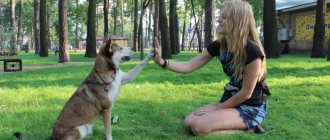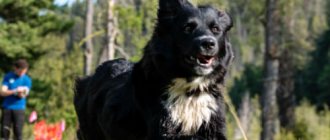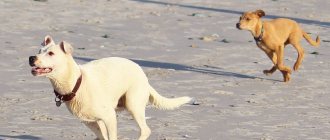If you get a dog, then you need to devote time to raising it, instilling discipline skills so that you are calm and those around you feel safe. The fastest way to resolve the situation is through training—teaching the dog commands. A disciplined dog will save you from:
- various problems while walking;
- destruction of a house or apartment;
- damage to clothes, shoes;
- dissatisfaction of passers-by;
- unexpected barking, squealing, and other things.
Raising a puppy and instilling discipline skills should be done starting from an early age - as experts recommend, from the moment the four-legged animal turns 3 months old.
Why do you need dog training?
Every owner wants to instill certain skills in their pet. For some, it is enough for a four-legged friend to bring slippers and calmly greet guests, others need reliable security, and others need an artist. All puppies are highly trainable, quickly acquiring specific skills with the right approach.
So, what is the purpose of learning commands?
- Educate.
The dog must understand the prohibitions and learn the simplest norms of behavior. This way all family members will feel comfortable around him.
- Discipline.
The four-legged friend, of course, is everyone’s favorite, but he must understand that the person is in charge. The animal gradually begins to respect and listen to the owner.
- Teach.
If a dog was purchased for certain activities (hunting, guarding, guiding), then it needs to be instilled with specific skills. This is usually done by experienced specialists.
The most pleasant bonus of training is the rapprochement between the owner and the animal. While playing happily, they respect and understand each other, which leads to a strong friendship.
Self-study or coach training?
Many believe that proper dog training is only possible under the guidance of a specialist. In fact, you can teach your pet a lot on your own. Of course, this is a labor-intensive task. Puppies are very smart, capable, kind, but at the same time naughty. They strive to run away from the owner and mind their own business. Therefore, training in the simplest commands must begin at 2-3 months.
The owner needs to be as patient and restrained as possible. Not everyone can do this, so many turn to dog handlers. But, if you got a puppy just for fun, without planning to teach him specific skills, then you can safely do home training.
Features of homeschooling
If you are concerned about how to train a dog at home, then remember that you need to be strict. If the student followed the order correctly, he should be praised, and if he disobeys, he should be reprimanded. Four-legged friends respond very well to intonation. It is enough to express dissatisfaction in a disappointed voice for the animal to understand its mistake.
Homeschooling has its advantages:
- classes in a familiar atmosphere eliminate stressful situations;
- the student listens only to his owner;
- no need to waste time on a trip to the dog handler;
- costs are reduced (travel, payment for specialist services).
At the same time, self-training has disadvantages:
- takes a lot of time and effort;
- limits training to a set of commands - not all skills can be taught at home;
- provides less training efficiency (especially if a particular breed is difficult to train);
- leaves the opportunity for the owner to commit incorrect actions, which often reinforces unwanted skills in the dog.
If you do not have the desire or experience necessary to train a breed that requires a special approach, consult a dog trainer. He will give recommendations on how to train a dog at home, taking into account its temperament and character. You may be interested in our article on dog handler prices.
It is also possible to train a mongrel, because it is not only purebred dogs that need training.
Specifics of training with an instructor
The owner himself makes the decision whether to train his four-legged friend at home or attend special courses.
Classes with a dog handler:
- save the dog owner’s time and energy;
- involve the issuance of a certificate, which will be needed if the dog participates in competitions and exhibitions;
- have regularity;
- guarantee results thanks to a professional approach.
But specialized courses also have disadvantages:
- a four-legged dog can take a long time to get used to a stranger, the school atmosphere, and experience stress;
- the owner needs to take action to transfer the skills acquired by the ward into real life;
- School services are quite expensive.
If you are seriously thinking about how to raise a dog at home and teach it commands, then know that one of the main points without which training is impossible is the owner’s self-discipline.
The latter should constantly work on himself, ensure regular training and rigor when training the puppy. If self-discipline is weak, then training should be entrusted to professionals.
Patience comes first!
If you are planning to buy a pet, the best option would be advice from a dog handler. The master will certainly tell you which breed is best for you. It happens that people take an animal straight from the street, for example, they feel sorry for a homeless puppy or an adult dog.
The challenge will be to toilet train your pet. It is impossible to punish a dog with a “whip”, it will work against the owner. In order for the dog to listen and, most importantly, understand, you will need:
- remain patient;
- have perseverance;
- show affection.
These three parameters are extremely important in raising an animal! Especially in taming street dogs. Remember, street pets are much more difficult to train.
Carpets will have to be removed from the floor; dogs prefer soft coverings as a “toilet”. If the dog is large, the toilet is outside. It is necessary to develop a certain “toilet” routine for your pet. If successful, the pet will try to endure it until the walk or will begin to whine, asking for time off to “go to the toilet.” If the dog is small, for example, a Spitz or a Chihuahua, it is possible to organize a toilet at home. You will need to purchase a special tray and fill it with sand or filler.
To ensure that your dog goes to the toilet at home only in the specified place, soak a cloth in urine and place it in the desired place. As a rule, animals smell the smell of a “toilet” and instinctively choose the “smelling” place. It is possible to monitor the dog; if you try to settle in the wrong place, move it to the right one. Try to contain negative emotions if your pet “goes to the toilet” in an inappropriate place. Remember, the desired result does not come quickly. Small dogs also need to be walked; it is permissible to refrain from walking only in case of severe frost, gusty winds or heavy rain.
As you know, dogs love to chew, especially puppies. Don't scold your kids for chewing on their slippers or wires. Probably, the body requires such an exercise: there are not enough vitamins or the teeth are simply itchy. Buy special bones, sold at a pet store. It is possible to offer simple bones from cooked soup. Slippers and wires should definitely be removed and hidden from the pet’s eyes.
Teaching Methodology
Many people think that you can’t raise or train an adult dog. They are confident that they can be trained only from puppyhood. This is not true.
Yes, kids learn various commands faster, so it’s easier to conduct classes with them. But an adult four-legged friend can also be trained. The main approach is regular training, proper handling, and great patience. You should not feel nervous if the dog does not immediately understand what the owner requires of him.
Where to train
The most favorable place for studying is an area that is well known to the student. It is advisable to exclude distracting circumstances: moving vehicles, active passers-by, other animals. If you happen to conduct training in an unfamiliar area, then you need to let your pet go for a walk and explore the territory. This will calm him down, and he will calmly return to his studies. When the dog gets used to one place, you can move to another area.
When to train
You can train at any time, subject to certain restrictions. You should not train a four-legged animal:
- immediately after he wakes up;
- in the heat - this can cause overheating, dehydration, and other unpleasant events;
- immediately after eating.
If you cannot avoid exercising during the hottest part of the day, take an adequate supply of drinking water.
What to take to training for encouragement
Reward your student with treats that he likes. This could be dry cookies or special food, cheese, meat, or other products.
In addition to treats, you can give your dog the right kind of praise. What does this mean? You need to encourage it right away. If the puppy has already completed the task a long time ago, and you just decided to praise him, then he will not understand it as it should.
Auxiliary items
For each training session it is necessary to take special items to facilitate the learning process.
- Trainer's bag for treats.
- Leashes - short (1 to 1.5 m long) and long (10 to 12 m long).
- Muzzle.
- Collars - regular and strict (made of metal). The latter is needed when the dog does not react to standard painful stimuli.
- Grip, or “rope”. This is a conditional opponent whom the student bites.
- Ringovka, aka noose. Used by applying physical force to adult quadrupeds. Models with a lock are attached to the desired location of the neck.
- Dumbbell - plays the role of prey. The student brings it with the order “Fetch!”, gives it to the owner with the command “Give!” You can't just play with her like that.
Take toys - a puller, an Arabian ball, a rope. They will help diversify the training process and facilitate learning.
Recommendations for self-study
Training dogs on your own requires compliance with the following recommendations.
- Regularity of classes. Or better yet, daily.
- Gradually increase the duration of classes. You can start with 15 minutes.
- Clear orders. Commands and rewards should be given different intonations so that the dog can distinguish them.
- Repeat the requirement no more than 2 times. Otherwise, the dog begins to understand that he doesn’t have to carry out the order the first time, but drags out time as long as he likes.
- Attracting the attention of your four-legged friend. To do this, use the animal's name, pronounced loudly and clearly.
- Constantly rewarding your pet for success. Use treats or praise, you can alternate.
Always maintain your composure if a student fails to complete assignments. If you raise your voice, your four-legged friend will also become nervous and quickly stop trusting you.
It is strictly forbidden to hit a dog.
Following the owner by a special signal
Teach your puppy to respond to a neutral signal, such as a snap of your fingers or a whistle. Having heard it, he should follow you. If you teach your dog to be nearby, even when the leash is not fastened, and to respond to a special signal, then the appearance of various distracting elements will not cause any problems.
A neutral signal is nothing more than a sound that gives the dog the impulse to pay attention to the owner and, therefore, follow him in the right direction.
Initially, training should be carried out in simple conditions and gradually add new distractions to which the puppy actively reacts. At the last stage of training, take your pet on a leash. With proper training, the leash will simply become an additional element for the dog; it should not pull on it and break.
A neutral signal can be very helpful when you accidentally find abandoned food on the walkway or your dog is too busy doing something he shouldn't be doing.
Step-by-step instructions for working out a neutral signal
Here the training is also divided into three stages. Prepare your pet's favorite treats and get started.
Remember that every dog is different, so training may require a different amount of training. Do not use force and always squat down near the puppy (or lean towards him) at the end of the exercise, play with him or pet him. Reward every success, even small ones, with treats.
- Tempt your puppy with a treat, and when he starts moving towards you, give a signal, such as snapping your fingers. It is important to be consistent and always use the same signal. Repeat the exercise several times and reward your dog with a treat and a kind word.
- Encourage your dog to follow you. This step is a little more difficult. Turn away from the puppy and slowly start walking in a different direction. Give the signal to follow you. Remember to always repeat the exercise several times and reward your little pupil for diligence.
- Distractions and focusing attention on the owner. This is the third stage of teaching a puppy a command. After all, there are plenty of distractions everywhere, especially in the city. Often you have to walk with your dog in crowded places, where someone, for example, is feeding pigeons, which the dog should not approach.
Under no circumstances should a puppy take food from the ground!
In such situations, giving a neutral signal will distract him and focus his attention on the owner. During training, it is best to use the food you feed your dog daily. Place the food on the ground, walk your dog on a leash, and when he becomes interested in the food, turn around and give a signal to distract him. If your puppy follows you, reward him with a treat and praise him.
"Serious" games with puppies
The way we teach a puppy commands determines his future behavior. By the age of 3 months, the baby should clearly know his place in the house and not litter the room.
The main commands for entry-level training are: “Fu”, “Come to me”, “Place”.
The duration of the first workouts should be 15-20 minutes. Gradually, the time can be increased to 40 minutes a day. Long exercises will lead to fatigue and disobedience. To avoid this, you need to take short breaks (5-10 minutes), ending your workouts on time. This applies to students of all ages (especially if adult dogs have not been trained before).
To punish a four-legged friend, a severe reprimand in a dissatisfied voice is enough.
Tips from dog handlers
Recommendations for training:
- Dividing the course into stages (teams study separately).
- Lack of rudeness on the part of the owner (even if the animal refuses to follow orders).
- Individual approach for each pet.
- The maximum duration of one lesson is 60 minutes.
- Preparing the necessary items in advance (collar, leash, treats for gratitude);
- Choosing a deserted area for conducting classes. An important condition, failure to comply with which can lead to serious consequences.
- Distraction from extraneous environmental factors.
- The pet must be given the opportunity to sniff the area before training (the belief that there is no danger allows the dogs to concentrate on following orders).
- The right choice of treats (using dry food so as not to stain the animal and the owner’s clothes).
Showing persistence and patience is the key to teaching an animal the necessary skills. After completing a training course, the animal becomes well-mannered and socially harmless to the people around it.
Training with adults
It is more difficult to train an adult student. There are 3 reasons for this:
- Presence of established behavioral habits and character.
- Puberty - the work of hormones prevents the dog from responding promptly and correctly to the owner’s orders.
- It is difficult to “swing” an adult, to teach him to behave in a new way.
Despite various difficulties, the training is a success. But at the same time, it is necessary to conduct classes consistently, treat the student carefully and patiently.
Prepare to devote time from 3 months to a year to basic training. Think over your training methods, focusing on the character of your adult four-legged friend.
Avoid negativity when communicating with the student, as well as sudden movements (especially if the dog has attacks of aggression). Talk to him constantly.
Earn your pet's trust. This will help both of you complete the necessary training faster. Be sure to bring your favorite treats to every workout. Change the training area so that the dog is interested in learning something new.
There are special electric collars that ensure the student's obedience. But this is inhumane. This method can only be used by professionals when the animal poses a danger to others.
What and how is happening?
As a result of a correctly learned “stand” command, after the appropriate words from the owner, the dog must take a standing position and remain in this position until a new instruction is received. In this case, the position of the animal’s head should be natural, and the gaze should be directed forward or towards the trainer. There is no need to take a stance while following the “stand” instruction. Although in competitions this will be an extra point. True, according to the standards, the task “stand” and the order to stand are two different instructions, which require different lessons to practice.
Main training commands
Basic orders correspond to instincts. By practicing regularly and patiently, the owner gradually understands how to train a pet so that it becomes attentive, obedient, and smart.
Before you begin training, it is necessary to develop the puppy’s skill of obedience and response to its name. Make sure that he immediately responds to your gestures, orders, and signs.
Below we have posted a list of basic commands, as well as brief instructions for practicing skills. Thanks to the information provided, self-training dogs will become an interesting activity for you.
"Sit!"
This is the first thing a puppy is taught. The order is used very often, since its main purpose is to calm the animal and force it to sit down at any time, regardless of the environment or the pet’s mood.
- When you start training, keep an eye on your puppy. As soon as he sits down, say “Sit!” Repeat over and over again so that your pet has a clear association between his actions and the words he hears. Gradually move on to fulfilling the person’s orders.
- To instill the skill, prepare treats and a short leash.
- Extend your hand with the treat upward (so that your pet can see it), clearly and calmly say “Sit!” Try to sit the puppy down. To do this, pull the leash up a little and lightly press on the pet's croup.
As soon as he follows the order, reward him (with a treat, praise).
"Lie!"
Owners do not use this command often, but it is necessary, for example, when visiting a veterinarian.
How to train a dog to follow orders.
- First, command “Sit!” After your pet sits, clearly say “Down!” and pull the leash down, slowly pressing on the withers.
- Act carefully and avoid sudden movements.
- The dog should lie flat, without leaning to one side.
Be sure to praise when the animal completes a task.
"Stand!"
Also a fairly common task. It helps a lot when the puppy needs to be dressed or brushed. The order is not complicated, but it is best to practice the skill when the pet reaches 6 months of age.
How to train a dog.
- First, give the command “Sit!”
- As soon as your four-legged friend sits down, clearly say “Stop!” and pick up the dog. The easiest way to do this is when the owner stands to the right of the pet. Grab it under your belly and lift it up.
- Hold this for 4-5 seconds, after which be sure to praise the student.
Be calm and patient. Otherwise there will be no benefit from the classes.
"Place!"
Usually your pet walks, rests, and plays where he wants. But there must be a special place in the apartment where the dog goes at the owner’s command. To practice this skill, use the corresponding “Place!” order.
How to properly train an animal to complete a task.
- Take the treat in your hand. Go to the mat with your puppy. Use your free hand to hold your pet's collar. Show him the reward in your other hand. Place it on the mat.
- Take the student to a distance, clearly command “Place!”, and release him.
- Increase the length of the distance each time. At the end of the training, your pet should return to his place, being in another room.
The key point of the training is that the animal should eat the treat from the mat, and not from the owner’s hand. This way training will give faster results.
How to teach a dog the commands “Come to me!”, “Near!”
Owners use these commands more often than others. The skill must be worked out perfectly, otherwise the pet will be impossible to control. Until the animal can clearly and timely follow these orders, it should not be allowed to walk without a leash.
- When you see that your four-legged friend is coming towards you, calmly and clearly say “Come to me!”
- As soon as your pet comes closer, attract its attention with a toy or treat.
- Gradually increase the distance between you and the puppy. It is necessary that the animal follows commands without seeing you, but only hearing you.
There are restrictions on the use of this order. If you plan to trim your pet’s claws or comb it, or carry out other procedures that are unpleasant for it, then do not use “To me!” This approach can cause a strong association of the team with fear, pain, and anxiety.
To master the execution of the order “Near!”, the pet must first run and play. This will make him less active and more receptive to activities.
- Moving slowly, keep the shortened leash close to the collar. Say “Nearby!” clearly.
- If the animal moves to the side, use a leash to return it to its place. Repeat the order.
- Once your four-legged friend has mastered the skill, speed up the walking pace. First use a quick step, then run. At the end of the training, change the pace, alternating speed with leisure.
The animal should always move parallel to the owner, being at the left leg. At the final stage, trained dogs perform the tasks “Come to me!”, “Near!” without a leash.
"Go for a walk!"
Usually this team takes a break from classes. The trainer rewards the animal with a walk after it completes a task. The coach gives the order “Walk!”, pointing in the right direction with his hand. Pets learn this skill very quickly; additional reinforcement in the form of treats or praise is not required to consolidate it.
“Give me your paw!”
The implementation of this order must be practiced in order to subsequently trim the pet’s claws and wash the pet’s paws without any effort. Dogs are trained as follows:
- Hide a treat in your hand and show it to your sitting four-legged friend. Do not open your palm until the dog tries to get the tasty piece with his paw.
- At this moment, say “Give me your paw!”, shake it, holding it in your hand.
- Reward the student.
Reward the animal every time it successfully completes a task (with a treat, praise).
“Ugh!”, “No way!”
A basic order that prohibits the puppy from continuing any activity. We teach the dog the commands “Ugh!” and “No!” in order to wean him from picking up unnecessary objects, throwing himself at people, and doing other things that disturb the peace of passers-by.
- Practice the skill on a loose leash.
- When the animal plans to disrupt public order or make other unwanted movements, sharply yank the leash, clearly, sternly saying “Ugh!”
The order should cause the student to associate with an unpleasant situation.
“Silence!”, “Quiet!”
You can begin mastering this command when the puppy reaches 2 months of age.
- The moment your pet starts barking, say “Quiet!” or “Be quiet!”
- When your four-legged friend is silent, reward him with a tasty morsel or kind words.
- Pause after the barking stops. If the student continues to remain silent, give him additional encouragement.
The animal should have a clear association - stopping barking means a reward.
“Aport!”
This order is an indispensable assistant when walking an active, energetic animal. You can start training your four-legged friend after the dog follows the commands “Come to me!” and “Sit!”
- Clearly say “Sit!”, show the puppy an interesting thing (toy, stick).
- The animal will want to take the item. Throw the stick or toy aside and command “Fetch!”
- Show your pet the direction in which to move.
If the dog starts playing, give the order “Come to me!” It is difficult for adult animals to develop a reaction to “Fetch!”; it is much easier to teach this to a baby.
"Voice!"
This command is quite difficult for four-legged friends to master. There are 2 ways. You can use both.
- Step on the leash in such a way as to limit the pet's range of action.
- Raise your hand with the tasty morsel up, give the order “Voice!” several times.
- The animal barks because it cannot get food.
- When the puppy vocalizes, reward him.
Make sure that the dog starts barking as soon as he hears the order.
Another method is to reward your pet when he begins to bark on his own at other animals or people. In this case, the four-legged friend must be in a place that is safe for others. Repeat “Voice!”, constantly rewarding the student for successful completion.
Remember that not all breeds like to vocalize. And some are not naturally able to do this.
"Fas!"
Team "Fas!" They train only four-legged animals that, having mastered the basic training course, have reached the age of 6 months. When ordered, the pet attacks the object. If the puppy has an unbalanced character, then you cannot teach him the task. In addition, training dogs at home does not involve mastering the skill, since in inexperienced hands the animal can become a dangerous weapon. The training is conducted only by a professional instructor.
"Wait!"
Usually the order is used in conjunction with “Sit!” and “Lie down!” To instill a skill in a student, proceed as follows:
- Stop with your four-legged friend in a certain place, calmly say “Sit!”
- When the dog completes the task, say “Wait!”
- Slowly moving back, repeat “Sit! Wait!".
If your pet has completed the task, approach him again and praise him. First, step back for 10 seconds. With each session, gradually increase the exposure time.
Seal
The essence of the trick is that the dog must sit motionless with a piece on his nose. Cheese is best: you can cut it into cubes and it fits comfortably on your nose.
Command the dog to “sit”, lightly close its mouth and at the same time say “freeze”. After 5 seconds, release your pet's face and repeat this command 5 more times. The dog's task is to learn to sit with its mouth closed for some time. After this, take a break.
After the break, repeat the training, but this time place a piece of cheese or other food on the dog’s nose. If necessary, close the mouth with your hand again. After 5 seconds, release the dog, say “ready” and take the piece from the muzzle. If the dog was able to balance the piece for 5 seconds, then be sure to reward it, but with a different treat. Don't forget to take a break after every 5 attempts. Continue training until the dog can balance the piece for at least 15 seconds.











